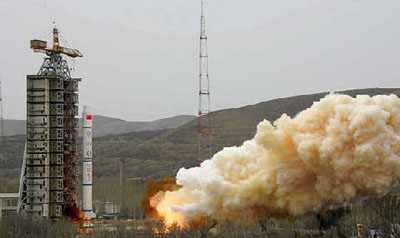The State Oceanic Administration has formally taken over the control of the "Haiyang-1B" (Ocean 1B) as of Sunday after the second self-designed oceanic survey satellite in China proved functioning well on its projected orbit for more than five months.
Sources with the Commission of Science, Technology and Industry For National Defense said that the satellite could capture real-time information and data on the marine resources and environment of the country's coastline, islands, territorial waters, continental shelves and exclusive economic zones.
The data collected will be used to facilitate the country's development and utilization of marine resources, construction of ports, monitoring and prevention of oceanic pollution, resource investigation and the development of coastal areas as well as for study of global environmental changes.
File photo: The "Haiyang-1B" satellite was launched on April 11, in Taiyuan, Shanxi Province.
Launched in April, the satellite with a designed operational life of three years, is also a crucial component of China's three dimensional oceanic survey system.
China launched its first oceanic survey satellite "Haiyang-1A" in May 2002 to monitor ocean color and temperature using remote sensing technology across the Bohai Sea, the Yellow Sea, the East China Sea and the South China Sea.
But the breakdown of a solar cell driver shortened Haiyang-1A's operational life from the designed two years to 685 days.
Scientists say Haiyang-1B had a stronger structure than Haiyang-1A, enabling it to withstand stronger shocks and jolts. It also had software and Internet capabilities that allowed it to repair itself in space as 10 computers would work together to repair the spacecraft in the event of a technical breakdown.
Haiyang-1A completed 1,830 surveys and provided oceanic information for 126 users including the oceanic administration, producers of oceanic products, research institutes and universities.
The government said it would need at least five more marisats in the medium term to develop the country's marine economy, provide a marine early warning system and safeguard the nation's maritime rights.
"Haiyang-1B" is developed by the China Academy of Space Technology of China Aerospace Science and Technology Corp (CASTC). It was launched on the 96th flight of a Long March carrier rocket, which was developed by the China Academy of Launch Vehicle Technology of the CASTC.
(Xinhua News Agency October 1, 2007)






